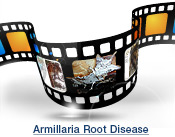| |
Armillaria Root Disease - Forest Health and Adaptation | |
| |
|
|
| |
|
|
| |  {GFX-ESRDx-ForestHealth-Armillaria-Slide2.jpg}{GFX-ESRDx-ForestHealth-Armillaria-Slide3.jpg}{GFX-ESRDx-ForestHealth-Armillaria-Slide4.jpg} {GFX-ESRDx-ForestHealth-Armillaria-Slide5.jpg}Armillaria root disease refers to decay of roots, root collar and bole caused by fungi belonging to Armillaria species. {GFX-ESRDx-ForestHealth-Armillaria-Slide2.jpg}{GFX-ESRDx-ForestHealth-Armillaria-Slide3.jpg}{GFX-ESRDx-ForestHealth-Armillaria-Slide4.jpg} {GFX-ESRDx-ForestHealth-Armillaria-Slide5.jpg}Armillaria root disease refers to decay of roots, root collar and bole caused by fungi belonging to Armillaria species.
It is found throughout Alberta and all tree species in the province can be infected by this disease.
Signs and Symptoms
Look for the following signs and symptoms of Armillaria root disease:
Crown
- Prematurely discoloured broadleaf tree
- Thinly foliated, completely fading green/yellow-orange or red-brown in young conifer trees
Foliage/Buds
- Broadleaf trees show abnormally yellow leaves (chlorotic)
- Conifer trees show fading green/yellow-orange needles or red-brown needles
Stem/Outer Bark
- Resinosis on lower stem/bole.
Wood/Inner Bark
- Decay
- Stain
- White mycelial fans
Root Collar/Root
- Dark brown shoestring-like fungal strands called rhizomorphs
- Decay
- Honey-coloured mushrooms in fall
- Resinosis in conifers
- Stain
- White mycelial fans
Similar Damage
- Can be confused with root weevils or winter desiccation
- Remove bark at root collar to check for white mycelia
|
|
| |
|
|
| |
For more information about the content of this document, contact Devon Belanger.
This information published to the web on February 24, 2016.
|
|